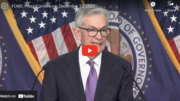Written by Jason Hoerr – Market Analyst for www.forextraders.com
Traditionally, Central Bankers control the fate of an economy by manipulating the money supply. When they lower short term interest rate targets, markets rise as liquidity floods the system, and when they raise short term interest rate targets, markets fall as liquidity tightens. Thus goes the typical monetary policy and economic cycle.
In 2008, the Fed lowered interest rates to near 0% in a desperate attempt to stave off another Great Depression and total economic collapse. When a Central Bank lowers rates that low, it essentially backs itself into a corner. If the economy does not respond to near 0% rates, what else can it do to stimulate economic growth and create demand? Enter Quantitative Easing.
QE
Quantitative Easing is a form of monetary stimulus, in which a Central Bank injects huge amounts of capital into the economy by purchasing treasury securities. Proponents of QE methods believe this extra liquidity can bolster demand and spur economic growth, while detractors believe it simply increases our debt, falsely inflates asset prices, and has little real positive economic affect.
In July 2010, Fed Chairman Ben Bernanke testified before Congress and stated that the Fed was ready and willing to initiate a second round of QE if economic conditions warranted it. The first round of QE that originated from the implosion of 2008 had come to an end, but the U.S. economy was still very weak. Immediately, the market rallied and began an aggressive upward climb, as market participants began pricing in a second round of QE.
As you can see in the chart above, the market rallied significantly during all of QE2. QE2 has now come to an end and the Federal Reserve is determining what it is going to do next.
Yesterday, Mr. Bernanke testified before Congress just as he did in July 2010, and Mr. Bernanke had a very similar testimony. He stated that he believed QE2 had done its job, which critics largely disbelieve, and he said that the Fed was closely monitoring economic conditions in order to determine whether another round of QE is necessary. Mr. Bernanke did state that the Fed would be willing to inject additional capital into the economy in the form of QE3 if economic conditions warranted it.
This rhetoric from Bernanke was not totally unexpected, but the market rallied significantly, nonetheless. The Dow Jones Industrial Average rallied nearly 200 points on the day off of Bernanke’s comments before the market sold off heavily in afternoon trading. The market seems unwilling to push price aggressively higher, but the mere mention of a QE3 possibility was enough for aggressive buying to flood the market for several hours.
Where Do We Go From Here?
After an aggressive rise over the last year, U.S. equity markets will most likely move into a sideways market within a few hundred points of the HI’s at 12,870. U.S. economic data is continuing to show that the economic recovery is struggling. Unemployment is still uncomfortably high and growth is muted. This combination will most likely cause the equity markets to begin correcting to some degree.
However, more talk from the Fed concerning QE3 will most likely be enough to push the market higher to test the 12,870 level. On the flip side, if the Fed remains silent and decides to hold off on QE3, there may be little incentive for buyers to pay this high of a price. In that instance, we could see a deeper correction, with the Dow testing the previous lows at 11,875. A break below 11,875 or a break above 12,870 will be a strong indication of trend continuation in one of those directions.







